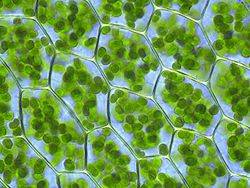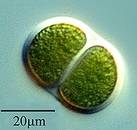Chloroplasts
Online Biology Dictionary
|
|
 Chlorplasts within the cells of Plagiomnium affine,
Many-fruited Thyme-moss. Image: Kristian Peters
Chlorplasts within the cells of Plagiomnium affine,
Many-fruited Thyme-moss. Image: Kristian Peters Chroococcus, a cyanobacterium
Chroococcus, a cyanobacteriumImage: X. Vazquez
Chloroplasts belong to a class of organelles known as plastids. They carry out photosynthesis in eukaryotic cells, the essential process that plants use to convert carbon dioxide into water and sugar in the presence of sunlight. As are other types of organelles, a chloroplast is enclosed in a lipid bilayer that forms a limiting membrane. Within is the stroma, a cytoplasm-like fluid.
All plastids of this type contain chlorophyll a (which is why most plants are green). But in some organisms they are not themselves green because they contain additional pigments affecting their color.
These sugar-producing organelles are thought to be the descendants of endosymbiotic cyanobacteria, and have circular chromosomes like those of prokaryotes. This circular genome, termed the plastome, codes mostly for redox proteins involved in electron transport during photosynthesis.
Within the stroma are the thylakoids, the hollow, nummiform bodies where photosynthesis takes place, which are arranged in a network composed of stacks called grana (sing. granum). Additional structural details of this organelle are shown in the enlargeable diagram at right.
Most shared on Macroevolution.net:
Human Origins: Are we hybrids?
On the Origins of New Forms of Life
Mammalian Hybrids
Cat-rabbit Hybrids: Fact or fiction?
Famous Biologists
Dog-cow Hybrids
Georges Cuvier: A Biography
Prothero: A Rebuttal
Branches of Biology
Dog-fox Hybrids